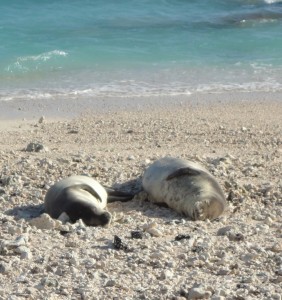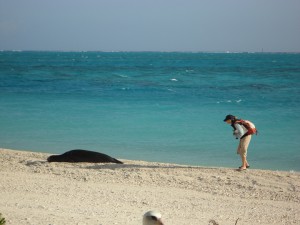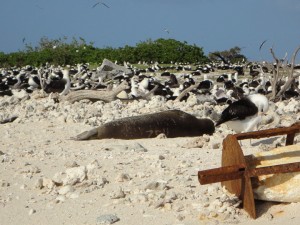Learning through experiences: monk seal field survey techniques.
We met at the boat dock just as the sun was fully rising above the tree-line. It was a fair bit windier today, though I have been told the wind is more typical for Midway in the winter (aka we’ve been spoiled thus far). While the rest of our classmates suited up in snorkel gear, Brianne and I stood near our bikes with only a life-vest and a backpack filled with water, sun-screen, our cameras and a peanut butter sandwich. Instead of heading out to the reef, we had the opportunity to experience a monk seal survey on Eastern Island with Tracy Wurth, a monk seal population biologist with NOAA. Tracy, who normally works on Oahu, has accompanied the Duke Marine Lab group in the past and graciously volunteers to include students in her work. This gives us an idea of what type of effort goes into monitoring monk seals— a population of marine mammals on the brink of extinction.
Once we waved goodbye to the boat, which promised to return and pick us up, we headed down the beach. I have worked with pinnipeds in Alaska and was excited to learn the techniques and methods used for monk seals as a comparison. Tracy explained the different types of surveys they conduct: from a full survey in which every monk seal on an island is accounted for and individually identified, to a more opportunistic survey of a portion of the island or seals. As we walked along the beach, it wasn’t long before we saw a long trail in the sand leading from the surf to the top of the beach. Slipping into “stealth-mode” we crept up to the edge of the vegetation when Tracy excitedly pointed. We’d found our first monk seal! Now it was time to get to work.

From a distance the observer assesses the age (juvenile, sub-adult or adult) and general condition of the animal. If any easily identifiable marks can been seen with the binoculars, they are recorded. Natural marks such as scars and natural pelage bleach-spots can be used to determine exactly which animal it is as almost every individual in the population is accounted for! If the markings are not distinct enough for the observer to ID the animal in the field they can use a database of pictures. However there are other ways to tell seals apart. Each seal has two tags placed in their hind-flippers as a weaned pup that will remain with them for a large portion of their lives. The tags are pretty small with unique colors and numbers. They are pretty small so the observer has to approach the animal a bit closer sometimes to read them. NOAA guidelines require people to remain beyond 150ft so as not to disturb the seals while they are sleeping or resting. However as a researcher, Tracy has permits that allowed her, as well as Brianne and I, to get a bit closer…so long as we moved with a ninja-like grace and did not disturb the seal.


Aside from natural marks and tags, field researchers use another method called “bleach-marking” to identify individual seals. Since natural marks and tags can often be hard to read without getting very close, researchers found that by bleaching the pelage (fur) of a seal they can temporarily mark seals with visible, unique numbers. It is a very nerve-wracking process, as you have to first ensure the seal is soundly asleep. If it looks like the seal is soundly asleep, you must then approach the seal without it seeing or hearing you (easier said than done on a beach full of coral rubble). If at any time the seal wakes up or even moves to get more comfortable, the bleaching is put on hold or scrapped. Monk seals haul-out onto land during the day to warm-up and rest, and most of the time don’t notice the quick act of someone squeezing the bleach mixture onto their fur. However, we do our absolute best to ensure they are not disturbed by our presence or actions.

Our class is EXTREMELY lucky to have the opportunity to actually perform a bleaching. Two of our classmates had this opportunity two days ago and Brianne and I each marked a seal today (the rest will get a chance later in the week).
The funniest part of this process was that I had always assumed they used some very expensive, scientific chemical bleaching agent, when in reality the researches basically use the same bleach mixture you can pick up and any hair salon!
While bleaching is performed when the opportunity presents itself, the majority of the survey consists of walking the beach and quietly observing. We battled against the wind and sand and sighted a total of 13 seals just on Eastern Island alone. It was also great just to have a chance to talk to Tracy about the research program, what is known about monk seals and more so, the large amount of information that is still being learned. In comparison to the other work I have done, it was thought-provoking to think about the similarities and differences in the research as well as management concerns. It would be great if there was one big solution–a band-aid that could be placed on all these problems–but reality is not so simple.
For example, one of the most striking moments was when we witnessed first-hand the aftermath of one of the threats monk seals face. About half way through the survey, we sighted a seal with scars left from when she was entangled in fishing line (view image below full screen to see it). The seal is now doing well and the scar has healed, but some seals are not so lucky. That sighting alone signified the incredible odds that are stacked against these amazing animals yet also reinforced how essential it is that we think about these issues in the bigger picture–not only for monk seals but for the health of the whole ocean.

After four and a half hours we finished the survey and headed home. The experience is still coursing through my mind. It is one thing to read about the population decline in scientific journals and text books, and another to walk the beach and see the animals and the environment in which they are trying to survive in person. I know the rest of my classmates will have just as wonderful of an experience when it is their turn and look forward to our future discussions about the state of monk seal conservation, what is being done, and what we still need to learn.

Hi guys, great that you are getting out to survey for seals! What’s happening with monk seals on Midway? Good year for pups? How many are around the island – and have any moved back and forth from Kure?
Great reading this year guys, makes me miss Midway more and more!
Cheers
Dj
Hello from your favorite advisees! This might show up twice because we’re not sure we did it right but here we go again. Most of the seals yesterday were Midway seals but we have seen a fair number of Kure seals and a few from Pearl and Hermes. The seal I bleached that’s been bopping around is from Kure. Overall Tracy says the seals look good especially for the Northwestern Hawaiian Islands. She has seen we think 31 different seals since we’ve been here.
We miss you too but we’ll see you soon and we can’t wait to meet our undergrads!
-H and B